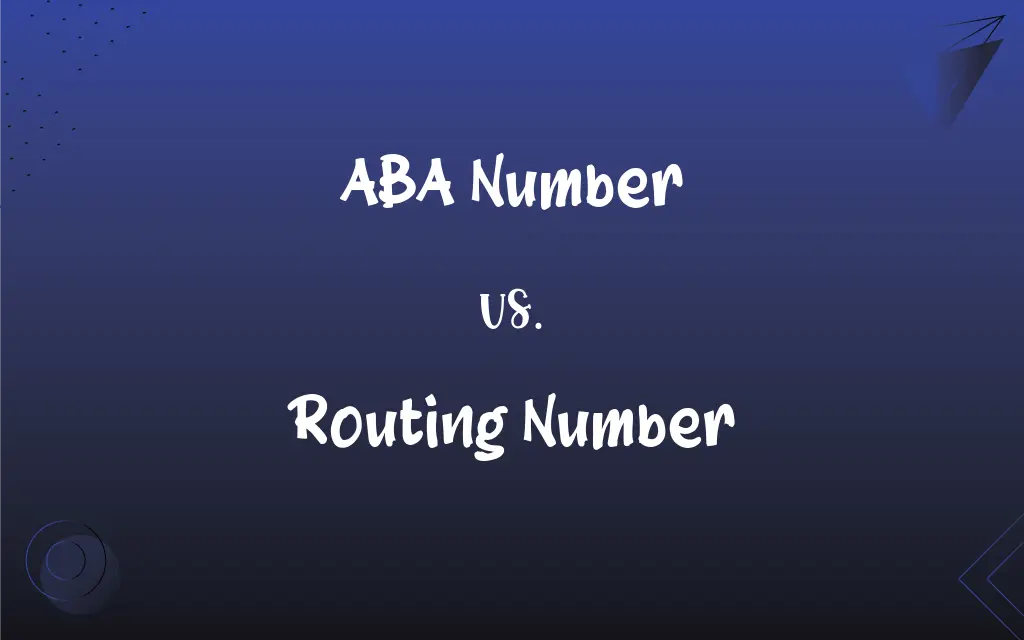ABA Number vs. Routing Number: What's the Difference?
Edited by Janet White || By Harlon Moss || Updated on May 30, 2024
An ABA number is a 9-digit figure used to identify banks in the U.S., while a routing number is synonymous with ABA number, used for sorting and identifying the bank for the transmission of their electronic items and paper.

Key Differences
The ABA number is essentially synonymous with the routing number, a nine-digit numerical code used to identify banking institutions within the United States. Banks utilize ABA numbers (American Bankers Association numbers) for efficient processing of numerous transactions, including electronic funds transfers and check processing. Simultaneously, the routing number has traditionally served as a pivotal tool to identify the specific financial institution responsible for honoring a given check.
The terms ABA number and routing number are used interchangeably within the banking sector and among consumers. Both numbers play crucial roles in the seamless execution of electronic transactions, which include direct deposits and automatic bill payments. Notwithstanding, the ABA number initially facilitated only paper check sorting and clearance among banks, ensuring that the check was sent to the correct corresponding banking institution.
Notably, while the ABA number was devised by the American Bankers Association in 1910, the advent of electronic banking broadened the routing number's function to facilitate automated electronic transfers. Nonetheless, whether discussing electronic transactions or paper checks, today’s practices often use the terms ABA number and routing number interchangeably due to their synonymous functionality.
ABA numbers and routing numbers offer clarity in the bank’s identification, safeguarding against potential errors in the transfer process. In the structure of these numbers, the first four digits pertain to the Federal Reserve routing symbol, while the subsequent four digits identify the bank or financial institution. The ninth digit, the check digit, is derived mathematically and validates the eight preceding numbers.
Comparison Chart
Definition
Unique bank identifier by ABA
Nine-digit code for financial institutions
ADVERTISEMENT
Primary Use
Check processing, wire transfers
Various transactions, direct deposits
Check Association
Printed on checks
Printed on checks
Online Transactions
Less common
Common for online and automated payments
Financial Systems
U.S. check clearing
Broad transaction facilitation
ABA Number and Routing Number Definitions
ABA Number
A unique code assigned to U.S. banks by the American Bankers Association.
To facilitate your wire transfer, you’ll need to enter the ABA number.
ADVERTISEMENT
Routing Number
A numerical code that facilitates the routing of checks and electronic payments within the U.S.
The routing number ensures that the payment reaches the right destination.
ABA Number
A bank code that directs electronic transfers and checks to the correct bank.
Without the correct ABA number, the transaction cannot be completed.
Routing Number
A 9-digit number used to identify banks when processing transactions.
Kindly confirm the routing number on your check to avoid any transaction delays.
ABA Number
A number system used to sort and clear checks between banks.
Her ABA number is printed on the bottom left of her checks.
Routing Number
A number synonymous with the ABA number, guiding transactions to the correct bank.
Each bank branch has a unique routing number to distinguish its transactions.
ABA Number
A numerical system that identifies banks within the United States.
Please provide your ABA number for the check to be processed correctly.
Routing Number
A number crucial for domestic wire transfers, direct deposits, and electronic transactions.
She found her routing number on her bank’s website for the wire transfer.
ABA Number
A 9-digit code established by the American Bankers Association to recognize U.S. financial institutions.
The ABA number is essential for ensuring that your transfer reaches the correct bank.
Routing Number
A banking code that directs electronic or paper transactions to the correct institution.
Your routing number is essential for setting up direct deposits.
FAQs
What is an ABA number?
The ABA number is a 9-digit code used to identify banks in the U.S., initially for check processing.
Can I perform a transaction without the ABA/routing number?
Generally, the ABA/routing number is crucial for many types of transactions to identify the bank accurately.
Why is a routing number essential for transactions?
Routing numbers help to direct electronic transactions and checks to the correct bank, ensuring secure and efficient processing.
Can a bank have multiple routing numbers?
Yes, larger banks, in particular, may have multiple routing numbers, often assigned based on the geographical location of the account.
Is the routing number different from the ABA number?
No, the terms "routing number" and "ABA number" are often used interchangeably in the banking context.
Is the ABA number necessary for international transactions?
Typically, international transactions require a SWIFT/BIC code, not the ABA number, which is used primarily for domestic transactions.
Can I find my routing number online?
Yes, routing numbers can often be found on a bank’s website or through their online banking portal.
Will my routing number change if I relocate?
It can change depending on your bank’s structure and whether they assign routing numbers by region.
Can I find the ABA number on my check?
Yes, the ABA number is typically found at the bottom of a check, before your account number.
Is it safe to share my ABA number?
While the ABA number is not confidential, ensure to share it only with trusted entities for transaction purposes.
How can I verify a routing number?
You can verify a routing number by contacting your bank or using an online routing number checker.
How many digits is a typical routing number?
A standard routing number is always nine digits long.
Are ABA numbers public information?
Yes, ABA numbers are not confidential and are often listed on a bank's website.
Why was the ABA number created?
The ABA number was introduced to efficiently sort and process checks by accurately identifying the paying bank.
Do all branches of a bank have the same routing number?
Not necessarily; routing numbers can differ by state and sometimes by branch within the same bank.
Do digital banks have routing numbers?
Yes, digital banks also have routing numbers to facilitate electronic transactions.
Can I locate my bank with the routing number?
Yes, the routing number can identify the bank and sometimes even the branch of a bank account.
Can two banks have the same ABA number?
No, ABA numbers are unique to each bank to avoid confusion in transaction processing.
Does the ABA number indicate my account details?
No, the ABA number identifies the bank but not individual account details.
What is the purpose of the 9th digit in the ABA number?
The 9th digit is a check digit, which is derived mathematically to validate the preceding eight digits.
About Author
Written by
Harlon MossHarlon is a seasoned quality moderator and accomplished content writer for Difference Wiki. An alumnus of the prestigious University of California, he earned his degree in Computer Science. Leveraging his academic background, Harlon brings a meticulous and informed perspective to his work, ensuring content accuracy and excellence.
Edited by
Janet WhiteJanet White has been an esteemed writer and blogger for Difference Wiki. Holding a Master's degree in Science and Medical Journalism from the prestigious Boston University, she has consistently demonstrated her expertise and passion for her field. When she's not immersed in her work, Janet relishes her time exercising, delving into a good book, and cherishing moments with friends and family.






























































